Activation of microglia depends on Na+/H+ exchange-mediated H+ homeostasis
- PMID: 21068326
- PMCID: PMC3010222
- DOI: 10.1523/JNEUROSCI.3950-10.2010
Activation of microglia depends on Na+/H+ exchange-mediated H+ homeostasis
Abstract
H(+) extrusion is important for sustained NADPH oxidase activation after "respiratory" burst in macrophage/microglia activation. In this study, we investigated the role of Na(+)/H(+) exchanger isoform 1 (NHE-1) in activation of microglia after lipopolysaccharide (LPS) or oxygen and glucose deprivation and reoxygenation (OGD/REOX) exposure. NHE-1 functioned in maintaining basal pH(i) of immortalized M4T.4 microglia or mouse primary microglia. Pharmacological inhibition of NHE-1 activity with the potent inhibitor cariporide [HOE 642 (4-isopropyl-3-methylsulfonyl-benzoyl-guanidine-methanesulfonate)] abolished pH(i) regulation in microglia under basal conditions. Activation of microglia either by LPS, phorbol myristate acetate, or OGD/REOX accelerated pH(i) regulation and caused pH(i) elevation, which was accompanied with an increase in [Na(+)](i) and [Ca(2+)](i) as well as production of superoxide anion and cytokines. Interestingly, inhibition of NHE-1 not only abolished pH(i) regulation but also reduced production of superoxide anion as well as expression of cytokines and inducible nitric oxide synthase. Together, these results reveal that there was a concurrent activation of NHE-1 in microglia in response to proinflammatory stimuli. The study suggests that NHE-1 functions to maintain microglial pH(i) homeostasis allowing for sustained NADPH oxidase function and "respiratory" burst.
Figures

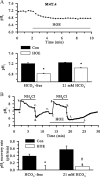
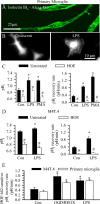

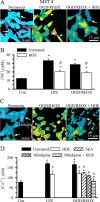

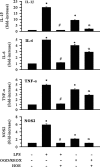
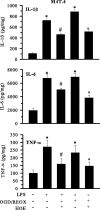


Similar articles
-
Coordinated role of voltage-gated sodium channels and the Na+/H+ exchanger in sustaining microglial activation during inflammation.Toxicol Appl Pharmacol. 2013 Dec 1;273(2):355-64. doi: 10.1016/j.taap.2013.09.011. Epub 2013 Sep 24. Toxicol Appl Pharmacol. 2013. PMID: 24070585 Free PMC article.
-
Role of sodium/hydrogen exchanger isoform 1 in microglial activation and proinflammatory responses in ischemic brains.J Neurochem. 2011 Oct;119(1):124-35. doi: 10.1111/j.1471-4159.2011.07403.x. Epub 2011 Sep 1. J Neurochem. 2011. PMID: 21797866 Free PMC article.
-
Sustained Na+/H+ exchanger activation promotes gliotransmitter release from reactive hippocampal astrocytes following oxygen-glucose deprivation.PLoS One. 2014 Jan 2;9(1):e84294. doi: 10.1371/journal.pone.0084294. eCollection 2014. PLoS One. 2014. PMID: 24392123 Free PMC article.
-
The role of Na(+)/h (+) exchanger isoform 1 in inflammatory responses: maintaining H(+) homeostasis of immune cells.Adv Exp Med Biol. 2013;961:411-8. doi: 10.1007/978-1-4614-4756-6_35. Adv Exp Med Biol. 2013. PMID: 23224899 Review.
-
Chronic inhibition of na(+)/h(+)-exchanger in the heart.Curr Vasc Pharmacol. 2006 Jan;4(1):23-9. doi: 10.2174/157016106775203117. Curr Vasc Pharmacol. 2006. PMID: 16472174 Review.
Cited by
-
Pyrethroid Insecticides Directly Activate Microglia Through Interaction With Voltage-Gated Sodium Channels.Toxicol Sci. 2017 Jan;155(1):112-123. doi: 10.1093/toxsci/kfw187. Epub 2016 Sep 21. Toxicol Sci. 2017. PMID: 27655349 Free PMC article.
-
The anti-parkinsonian drug zonisamide reduces neuroinflammation: Role of microglial Nav 1.6.Exp Neurol. 2018 Oct;308:111-119. doi: 10.1016/j.expneurol.2018.07.005. Epub 2018 Jul 12. Exp Neurol. 2018. PMID: 30017881 Free PMC article.
-
Coordinated role of voltage-gated sodium channels and the Na+/H+ exchanger in sustaining microglial activation during inflammation.Toxicol Appl Pharmacol. 2013 Dec 1;273(2):355-64. doi: 10.1016/j.taap.2013.09.011. Epub 2013 Sep 24. Toxicol Appl Pharmacol. 2013. PMID: 24070585 Free PMC article.
-
Chronic neurological deficits in mice after perinatal hypoxia and ischemia correlate with hemispheric tissue loss and white matter injury detected by MRI.Dev Neurosci. 2011;33(3-4):270-9. doi: 10.1159/000328430. Epub 2011 Jun 24. Dev Neurosci. 2011. PMID: 21701150 Free PMC article.
-
Deletion of Slc9a1 in Cx3cr1+ cells stimulated microglial subcluster CREB1 signaling and microglia-oligodendrocyte crosstalk.J Neuroinflammation. 2024 Mar 20;21(1):69. doi: 10.1186/s12974-024-03065-z. J Neuroinflammation. 2024. PMID: 38509618 Free PMC article.
References
-
- Bedard K, Krause KH. The NOX family of ROS-generating NADPH oxidases: physiology and pathophysiology. Physiol Rev. 2007;87:245–313. - PubMed
-
- Block ML, Hong JS. Chronic microglial activation and progressive dopaminergic neurotoxicity. Biochem Soc Trans. 2007;35:1127–1132. - PubMed
-
- Boscia F, Gala R, Pannaccione A, Secondo A, Scorziello A, Di Renzo G, Annunziato L. NCX1 expression and functional activity increase in microglia invading the infarct core. Stroke. 2009;40:3608–3617. - PubMed
-
- Boyarsky G, Ransom B, Schlue WR, Davis MB, Boron WF. Intracellular pH regulation in single cultured astrocytes from rat forebrain. Glia. 1993;8:241–248. - PubMed
-
- Brookes PS, Yoon Y, Robotham JL, Anders MW, Sheu SS. Calcium, ATP, and ROS: a mitochondrial love-hate triangle. Am J Physiol Cell Physiol. 2004;287:C817–C833. - PubMed
Publication types
MeSH terms
Substances
Grants and funding
- P30 HD003352/HD/NICHD NIH HHS/United States
- NS43802/NS/NINDS NIH HHS/United States
- UL1 RR025011/RR/NCRR NIH HHS/United States
- R01 NS056118/NS/NINDS NIH HHS/United States
- P30 HD03352/HD/NICHD NIH HHS/United States
- R01 NS048216/NS/NINDS NIH HHS/United States
- NS36736/NS/NINDS NIH HHS/United States
- NS56118/NS/NINDS NIH HHS/United States
- NS45048/NS/NINDS NIH HHS/United States
- R01 NS038118/NS/NINDS NIH HHS/United States
- R01NS048216/NS/NINDS NIH HHS/United States
- R01 NS043802/NS/NINDS NIH HHS/United States
- 1UL1RR025011/RR/NCRR NIH HHS/United States
- R01 NS036736/NS/NINDS NIH HHS/United States
- R01 NS045048/NS/NINDS NIH HHS/United States
LinkOut - more resources
Full Text Sources
Miscellaneous
